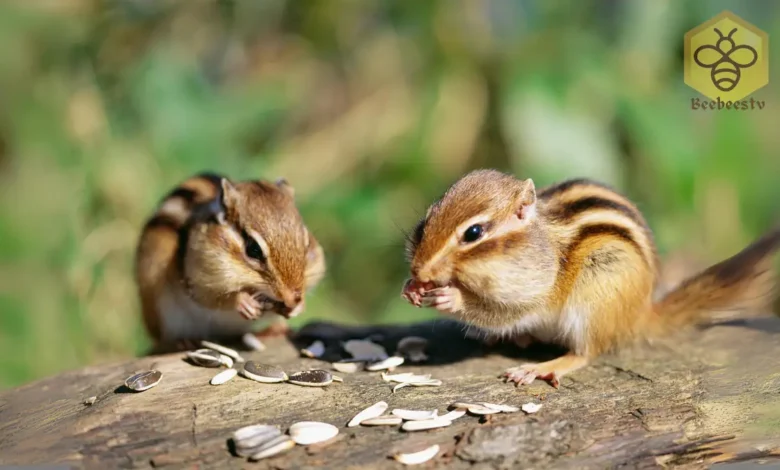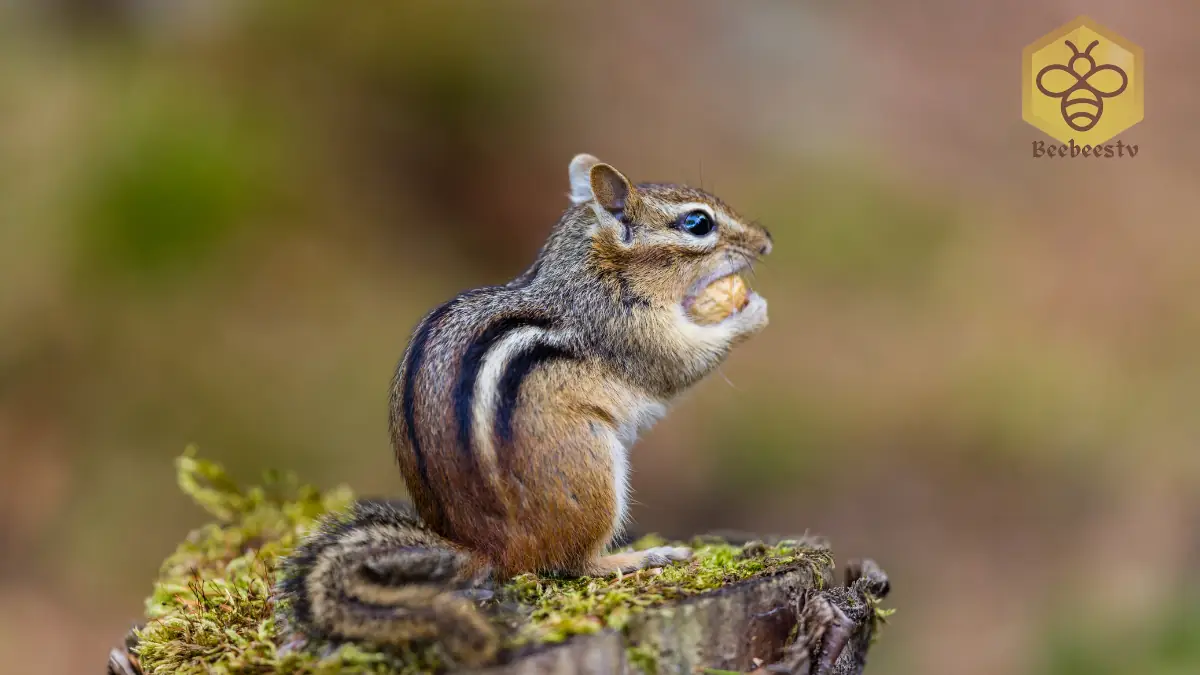Chipmunks: Habitat, Diet, Reproduction, Size, and more…

Chipmunk: Nature’s Small, Quick, and Resourceful Rodents
Chipmunk: Classification, Characteristics, Habitat, Facts, and More…
Introduction
Chipmunks are small, energetic rodents known for their quick movements, curious nature, and unique striped patterns. These tiny mammals play an essential role in their ecosystems, helping to disperse seeds and aerate soil. Found throughout North America and parts of Asia, chipmunks are highly adaptable creatures that have fascinated humans for centuries.
Scientific Name
The scientific name for the most common species of chipmunk, the Eastern chipmunk, is Tamias striatus.
Common Name
Chipmunks are often referred to by their common name “chipmunk,” though they are sometimes called “ground squirrels” or “striped squirrels” due to their appearance and burrowing habits.
Scientific Classification
| Kingdom | Animalia |
| Phylum | Chordata |
| Class | Mammalia |
| Order | Rodentia |
| Family | Sciuridae |
| Genus | Tamias |
| Species | Approximately 25 species, including Tamias striatus (Eastern chipmunk) and Tamias minimus (Least chipmunk). |
Types of Chipmunks
There are around 25 species of chipmunks, with the majority residing in North America. Some notable species include:
- Eastern Chipmunk (Tamias striatus): The most common and well-known chipmunk species in North America.
- Least Chipmunk (Tamias minimus): Smaller and more widespread, found throughout the western U.S. and Canada.
- Siberian Chipmunk (Tamias sibiricus): The only species native to Asia, specifically found in Russia, China, and Japan.
Habitat
Chipmunks are highly adaptable and can thrive in a variety of habitats. They are often found in forests, woodlands, and shrublands, but they also live in grasslands, mountains, and urban parks. Their burrowing habits allow them to create intricate underground homes where they store food, sleep, and raise their young. Chipmunks prefer habitats with plenty of vegetation and ground cover, where they can hide from predators and gather food.
Some species, like the Eastern chipmunk, are commonly seen near human dwellings, making gardens and backyards part of their habitat.
Physical Characteristics
Chipmunks are small rodents, generally measuring between 7 to 11 inches in length, including their tails. They have reddish-brown to grayish fur with distinct dark and light stripes running down their backs and faces, which help camouflage them in their natural environment.
- Size: They typically weigh around 2 to 5 ounces.
- Tail: Their bushy tail, while not as long as that of squirrels, is essential for balance and communication.
- Eyes and Ears: Chipmunks have large, dark eyes that provide excellent vision and small, rounded ears that give them an acute hearing.
- Feet: Their nimble feet and sharp claws are perfect for climbing trees and digging burrows.
Diet
Chipmunks are omnivores, feeding on a wide variety of foods. Their diet primarily consists of seeds, nuts, fruits, and fungi, but they are opportunistic and may also eat small insects, bird eggs, and even baby birds. Chipmunks are known for their cheek pouches, which they use to store and transport food back to their burrows.
- Favorite Foods: Acorns, sunflower seeds, berries, mushrooms, and grains.
- Food Storage: Chipmunks are famous for hoarding food, especially during the fall, to prepare for winter hibernation. Their burrows contain several food chambers where they store their stashes for the cold months.
Predators and Threats
Due to their small size, chipmunks have a wide range of predators. Common predators include:
- Birds of Prey: Hawks and owls often hunt chipmunks.
- Mammals: Foxes, coyotes, weasels, raccoons, and domestic cats are all-natural enemies of the chipmunk.
- Snakes: Various species of snakes also prey on chipmunks, particularly when they enter their burrows.
In addition to natural predators, chipmunks face threats from habitat destruction, particularly from urban development and deforestation. Climate change, which affects their food supply and habitat, can also pose long-term challenges for chipmunk populations.

Reproduction, Babies, and Lifespan
Chipmunks breed twice a year, typically in the spring and late summer. Female chipmunks give birth to 3–5 babies per litter after a gestation period of about 30 days. The babies, known as pups, are born blind and helpless, relying entirely on their mother for care. They remain in the burrow for the first six weeks before venturing outside.
- Lifespan: In the wild, chipmunks generally live for 2–3 years, although they can live longer in captivity, sometimes reaching 8 years.
Population
Chipmunks are generally abundant throughout their range, and their populations are considered stable. In some areas, especially in urban settings, chipmunks are quite common. However, localized threats like habitat destruction or increased predator presence can impact populations in certain regions.
Behavior and Lifestyle
Chipmunks are diurnal, meaning they are active during the day and sleep at night. They are solitary animals, except during mating season and when mothers are raising their young. Chipmunks are known for their high energy, spending much of their time foraging for food and defending their territories from intruders.
- Hibernation: Chipmunks hibernate during the winter, though they do not enter a deep hibernation like some other animals. Instead, they wake periodically to eat from their stored food supplies.
- Communication: Chipmunks communicate through high-pitched chirps, especially when alarmed or threatened. They also use body language, like tail flicking, to signal danger or assert dominance.
Ecological Role
Chipmunks play an essential role in maintaining healthy ecosystems. As seed dispersers, they help regenerate forests by spreading seeds far and wide, contributing to plant growth. Their burrowing habits aerate the soil, which enhances soil health and promotes better water absorption. By preying on insects and small invertebrates, chipmunks also help control pest populations.
FAQs
- What do chipmunks eat?
Chipmunks eat a variety of foods, including seeds, nuts, fruits, fungi, insects, and occasionally small vertebrates like baby birds. - Do chipmunks hibernate?
Yes, chipmunks hibernate during the winter but periodically wake up to eat from their food stores. - How long do chipmunks live?
In the wild, chipmunks live 2–3 years, though they can live longer in captivity. - Are chipmunks social animals?
Chipmunks are generally solitary creatures, except during mating season or when raising their young. - Do chipmunks climb trees?
Yes, they are excellent climbers, often ascending trees in search of food or to escape predators.
Conclusion
Chipmunks are small but vital members of their ecosystems, contributing to seed dispersal, soil health, and even pest control. Their adaptability and resourcefulness allow them to thrive in a variety of habitats, from forests to urban areas. Despite their playful and curious nature, chipmunks face threats from predators and human activities, making it essential to protect their habitats. These delightful creatures remind us of the importance of preserving natural spaces for wildlife and maintaining the biodiversity that supports our planet’s health.


